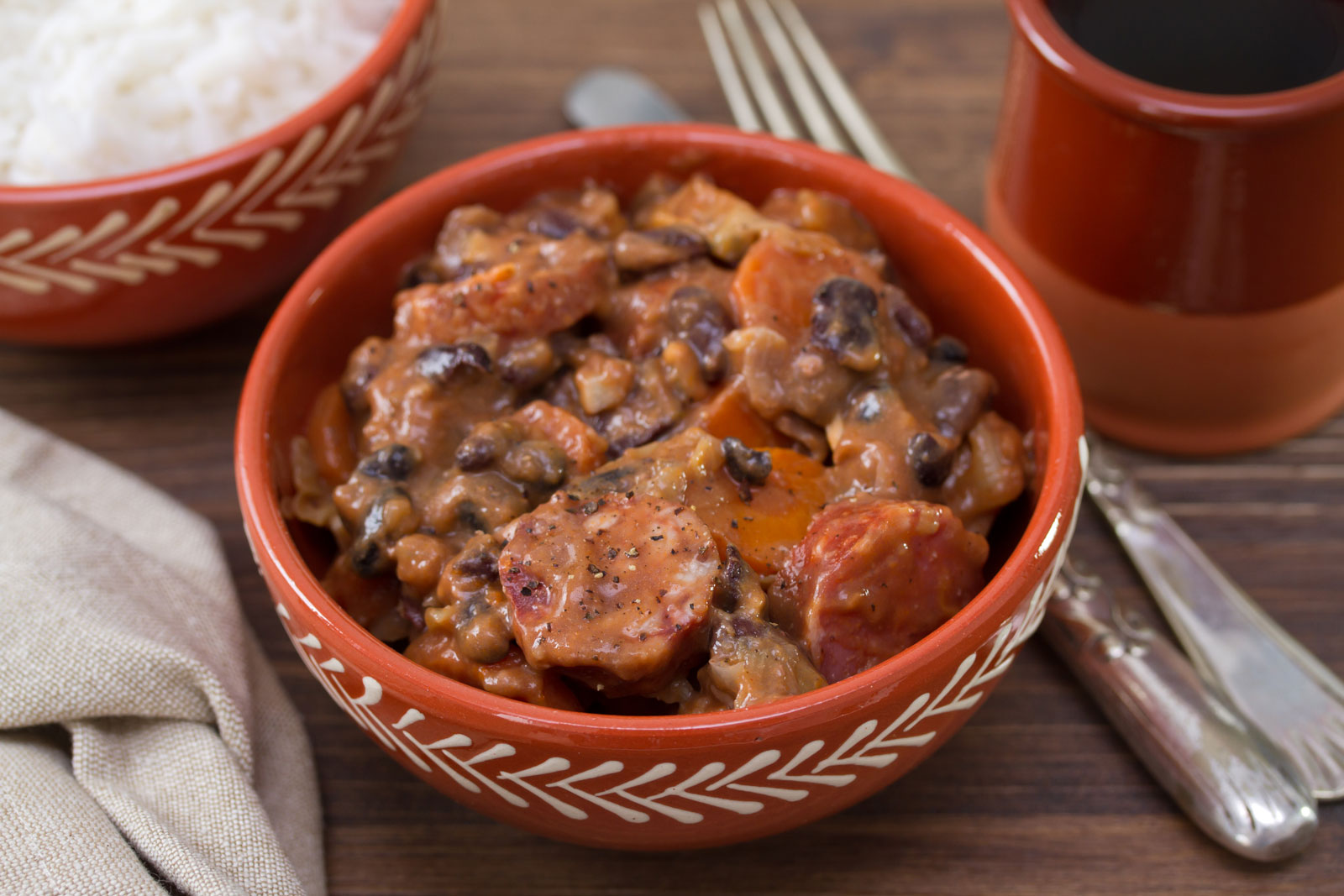Summary
- Traditional Portuguese Food
- 1. Pastel de Nata
- 2. Peixe Grelhado
- 3. Sardinhas
- 4. Piri Piri Chicken
- 5. Peixinhos da Horta
- 6. Olive Oil
- 7. Arroz de Pato
- 8. Picanha
- 9. Bacalhau
- 10. Caldo Verde
- 11. Bitoque
- 12. Francesinha
- 13. Bolinhos de Bacalhau
- 14. Port Wine
- 15. Linguica
- 16. Pão de Deus
- 17. Serra da Estrela Cheese
- 18. Bola de Berlim
- 19. Cebolada
- 20. Carne de Porco Alentejana
- 21. Ovas
- 22. Arroz de Marisco
- 23. Feijoada
- 24. Caldeirada de Peixe
- 25. Cozido à Portuguesa
- 26. Bifana or Prego
- Final Thoughts on Portuguese Cuisine
The Ultimate Guide to Portuguese Cuisine
Visiting Portugal is lovely for many reasons, but one of the most significant is the delicious Portuguese cuisine. While it is renowned for its flavorful seafood dishes, the culinary landscape offers a variety of traditional foods rooted in local customs and recipes.
Imagine savoring a Pastel de Nata, experiencing the spicy delight of Piri Piri chicken, or enjoying a small glass of port wine. The great news is that many of these delightful dishes can be recreated in your own kitchen, allowing you to enjoy the essence of Portuguese flavors without the need for travel.
Traditional Portuguese Food
Feeling eager to try some traditional Portuguese delicacies? You should be! Portuguese recipes are bursting with flavor—whether they are smothered in spicy sauce or lightly drizzled with lemon juice. Here are some of the best Portuguese dishes that you must sample.
1. Pastel de Nata
Pastel de nata is a beloved Portuguese dessert. This crispy pastry is filled with creamy egg custard, typically adorned with cinnamon and powdered sugar, similar to a crème brûlée. Best enjoyed fresh and warm from the oven, these delicious custard tarts are undoubtedly among the finest desserts Portugal has to offer.
The tasty origins of Pastel de Nata can be traced back to a group of monks in Lisbon during the 18th century. They crafted these tarts to generate income for the monastery, selling their recipe after its closure.
Today, you can find Pastel de Nata in bakeries, cafes, and restaurants throughout the country, and it’s quickly becoming a national dish. The challenge lies in perfecting the flaky pastry, which, when executed correctly, offers a sublime texture that nearly shatters with each bite. To capture the essence of freshness, it’s recommended to cook and consume this delightful dessert on the same day.
2. Peixe Grelhado
Peixe Grelhado, meaning grilled fish, is a straightforward yet rewarding dish. When you order this at a restaurant, you can expect to be served a whole grilled fish—a presentation that may initially seem overwhelming. However, once you sample the first bite, any hesitation will dissolve, especially with the addition of Portuguese olive oil drizzled generously over it. Indeed, Peixe Grelhado embodies the beauty of simplicity.
This dish is typically accompanied by herby-boiled potatoes, steamed vegetables, and a light salad. The focus is the grilled fish itself, often prepared over a charcoal grill to enhance flavor.
Common fish used in Peixe Grelhado include seabass, golden bream, and grouper. With a rich tradition of fishing in Portugal, grilled fish has long been a staple of the local diet, cherished across generations.
3. Sardinhas
Freshly grilled sardines are an iconic and succulent dish in Portuguese cuisine. While once a food primarily consumed by the lower classes due to their affordability and nutritional value, they remain one of the most cost-effective seafood options available in Portugal today. These grilled sardines make a fantastic snack or light lunch.
With a robust flavor, sardines are often salted before grilling, and the secret to achieving the perfect stickiness lies in the grilling method. Ensuring a slow grill maintains their moisture and flavor.
The ideal time to indulge in freshly grilled sardines is between June and October when the fishing season is in full swing. Alternatively, canned sardines are widely accessible across Portugal and abroad, providing an easier option. If you’re feeling adventurous, you might even sample sardines raw—offering yet another opportunity to experience this celebrated fish.
4. Piri Piri Chicken
Piri Piri chicken is a globally recognized dish, thanks in part to the widespread popularity of chains like Nando’s. This spicy and sweet chicken is coated in a flavorful sauce made from ingredients like lemon, pepper, garlic, bay leaves, vinegar, chili, and olive oil. Every chef has their unique take on Piri Piri sauce, so there’s always an opportunity to explore different variations.
The origins of the Piri Piri pepper date back to Portuguese colonizers who discovered it in their overseas territories and brought it back to the homeland, incorporating it into the local cuisine.
Often served with French fries and a light salad, Piri Piri chicken is easily found in restaurants both in Portugal and internationally. Those looking to recreate this dish at home will find that it is quite manageable, especially with available recipes.
5. Peixinhos da Horta
This dish represents one of the more eclectic appetizers in Portuguese cooking. Peixinhos da Horta translates to “little fishes from the garden” and consists of green beans coated in a light batter and deep-fried—traditionally prepared on ships to prevent vegetables from spoiling.
The process involves boiling green beans, covering them in batter, and quickly deep-frying them in olive oil. The outcome is a wonderfully crispy exterior encapsulating soft green beans—perfect for sharing among friends.
Not only is Peixinhos da Horta easy to prepare at home, but it is also featured commonly in local Portuguese eateries, making it an excellent choice to try as a side dish or an appetizer.
6. Olive Oil
While not a dish per se, olive oil plays an indispensable role in Portuguese cuisine, earning it a dedicated section. Portugal ranks among the world’s largest producers of olive oil, acclaimed for its rich, often nutty flavor, typically exhibiting a deep greenish-yellow hue.
Galician olives are the most commonly utilized variety, prized for their heritage and unique flavor profile. Beyond its culinary uses, olive oil production encapsulates Portugal’s cultural and agricultural history.
The production process for olive oil is extensive, beginning with the harvesting of olives from November to January, followed by washing, pressing, and extracting the oil through heating.
7. Arroz de Pato
Arroz de pato, translating to ‘duck rice,’ is a quintessential Portuguese dish that combines rice with garlic, bay leaves, wine, and chorizo for rich flavor. Prepared similarly to risotto, the rice is sautéed with onions and fat to encapsulate all those intense tastes.
Preferably made with wild duck, known for its leaner profile and stronger flavor, Arroz de pato is often presented with decorative slices of chorizo on top. This dish is hearty and satisfying, making it ideal for family gatherings and available at many local restaurants.
8. Picanha
Picanha, a cut of beef traditionally cooked over a Brazilian barbecue, owes its popularity in Portugal to historical ties with Brazil, a former Portuguese colony. As the Brazilian barbeque remains a favorite, this dish, utilizing the tender top sirloin cap, can be savored widely in Portugal, where it now has its own set recipe.
This particular cut is highly sought after for its tenderness and flavor, owing to a layer of fat nestled beneath the meat. When grilled, it becomes irresistibly mouthwatering.
9. Bacalhau
Undeniably, seafood is a prominent feature of the Portuguese diet, and Bacalhau (cod) deserves a spot on your must-try list. Bacalhau, or dried and salted cod, offers a unique flavor that remains mildly sweet despite its salinity.
Healthy and nutritious, Bacalhau is rich in omega oils, high in protein, and low in fat, making it an excellent option for frequent enjoyment. Historically, it served as an alternative to fresh fish, as its longevity made it an economical choice for families when fishing was not feasible.
10. Caldo Verde
If you’re in search of a comforting dish on a chilly day, Caldo Verde is the perfect soup option. This delightful soup primarily features shredded cabbage along with potatoes, olive oil, onion, and garlic, seasoned simply with salt and pepper. The vibrant green dish occasionally garnished with slices of chorizo.
Originating in Northern Portugal’s Minho region, Caldo Verde has spread throughout the country and is easy to replicate at home. It’s a versatile dish suitable for a light summertime brunch or a substantial winter meal.
11. Bitoque
Bitoque stands as a comforting Portuguese meal, typically featuring a lean steak—be it pork or beef—elevated by a fried egg on top and served with fries. As a basic farmer’s dish, its simplicity is nothing short of classic in Portugal.
Yet, the cooking method is key: the steak is seared in butter, enhancing tenderness while ensuring a distinctive flavor and texture. Bitoque serves as a typical lunch option available at many local eateries, often enjoyed with tomato sauce or mustard.
12. Francesinha
Francesinha is a celebrated Portuguese sandwich that consists of multiple layers stuffed with various meats and smothered in melted cheese. If you seek a filling meal, Francesinha won’t disappoint.
This towering sandwich features sausage, ham, and steak, layered between slices of white bread, finished with extra melted cheese and a savory beer-based sauce. It’s messy yet delicious, best enjoyed seated with a fork and knife for easy handling.
Originating from Porto, Francesinha is often referred to as the queen of sandwiches and was inspired by the French Croque Monsieur. Although it’s a more recent addition to Portuguese cuisine, dating back to the 1950s by Daniel Silva, it has become an essential dish to try during a visit.
13. Bolinhos de Bacalhau
Building upon the popular Bacalhau, Bolinhos de Bacalhau is a delightful variation. These bite-sized, deep-fried balls are prepared with potatoes, Bacalhau, eggs, parsley, and onion—perfectly suited as snacks or appetizers.
The preparation involves mixing Bacalhau with mashed potatoes and other ingredients before shaping them into torpedo shapes and frying until golden brown. Best served fresh, Bolinhos de Bacalhau boast a satisfying crunch on the outside and warmth within.
14. Port Wine
Although not a dish itself, Port wine undeniably stands out as the quintessential Portuguese drink. Created to maintain quality during long journeys, merchants began fortifying Portuguese wine with brandy in the 17th century, leading to its popularity worldwide.
Known for its sweet, intense flavor, Port wine typically has a higher alcohol content and is often enjoyed as a dessert wine, served in smaller glasses. For a genuinely immersive experience, savoring Port wine at a cozy Portuguese restaurant is a must.
15. Linguica
Linguica is a spicy Portuguese sausage known for its strong flavor. Typically made from a blend of pork, garlic, paprika, and chili, Linguica can be enjoyed on its own or as part of other dishes, such as Caldo Verde. A notable feature of Linguica is its preparation through smoking, which adds an exceptional flavor.
16. Pão de Deus
Transitioning to breakfast, Pão de Deus is a traditional Portuguese bread roll known for its soft, fluffy interior. Shaped into convenient single-serving portions, it’s ideal for a quick morning treat.
Translating to “God’s bread,” it was originally baked in convents centuries ago. This sweet, brioche-like roll, often topped with coconut and powdered sugar, is the perfect way to kick-start your day.
17. Serra da Estrela Cheese
Almost every Portuguese cheese is worth a taste, but Serra da Estrela cheese excels among them. This distinct yellow cheese originates from the mountainous Serra da Estrela region, crafted from the milk of Bordaleira sheep and dating back to the 16th century, symbolizing a rich cultural heritage.
Serra da Estrela cheese includes Cardoon plant, a wild thistle that contributes a floral, tangy note. This ingredient is integrated early in the process, with oil applied to the rind post-solidification.
18. Bola de Berlim
Ready to indulge in another sweet delight? Bola de Berlim are sweet, fried doughnuts without holes, instead featuring a creamy filling sandwiched between two doughnut layers. A Portuguese take on German doughnuts, they offer a luscious cream filling instead of jam, resulting from Jewish-German influences in Portugal during the 1930s.
19. Cebolada
Cebolada is a savory onion stew, often accompanying dishes like fish, potatoes, or bread rolls. The mix includes tomatoes, bell peppers, parsley, and garlic, slowly sautéed to create a robust sauce.
This versatile dish thrives in both restaurant settings and family dinners, providing an ideal option for larger groups.
20. Carne de Porco Alentejana
Carne de Porco Alentejana represents a unique blend of meat and seafood. This hearty dish marries pork with clams, complemented by potatoes and chopped coriander, making it an ideal evening meal for gatherings.
Though named after Alentejana, known for its prized black pigs, this dish actually originated in the Algarve region. Today, it’s widespread across Portugal and a delightful way to enjoy both seafood and traditional pork flavors.
21. Ovas
Ovas presents an adventurous choice among Portuguese dishes. This delicacy consists of fish roe, derived primarily from grey mullet. Originating from ancient preservation techniques, this dish showcases a smooth, silky texture and can often be found served with potatoes and vegetables, drizzled with oil and vinegar.
22. Arroz de Marisco
Shifting back to seafood, Arroz de Marisco offers a delightful rice dish reminiscent of Spanish paella. Unlike paella, however, Arroz de Marisco maintains a thicker, stew-like consistency. Expect a medley of prawns, mussels, clams, and squid, finished with herbs and a generous splash of white wine.
Historically found in Portugal’s coastal areas due to fresh seafood abundance, Arroz de Marisco is now also found inland and is relatively simple to recreate at home.
23. Feijoada
Deeply rooted in Portuguese heritage, Feijoada is a traditional stew made from black beans, pork, and beef. Historically, this dish utilized cheaper meat cuts to reduce waste and provide an economical meal. While still moderately salty, the natural flavors from meats and beans create a satisfying taste.
It’s a warming dish cherished in Portugal, especially good for chilly winter days.
24. Caldeirada de Peixe
Caldeirada de Peixe is a comforting fish and potato stew, often seasoned with saffron and enhanced by an array of seafood, including prawns and squid. This adaptable dish reflects whatever is freshly caught and showcases regional variations.
25. Cozido à Portuguesa
Cozido à Portuguesa may appear mismatched, featuring an assortment of meats and vegetables, but it’s prepared as a healthy boiled meal. Typical meats include pork ribs, beef, chicken, bacon, and sausages, while vegetables like turnips, potatoes, carrots, and cabbage complement this hearty dish.
Believed to have its origins in Beira, Cozido à Portuguesa is now prepared throughout the country, making it a convenient option for utilizing leftovers.
26. Bifana or Prego
As previously mentioned, Francesinha reigns as the queen of Portuguese sandwiches. But if that’s the case, Bifana and Prego are the princesses. These sandwiches offer simple yet delectable flavors, primarily served as takeaway meals.
Bifana sandwiches feature marinated pork, while Prego sandwiches showcase marinated beef, both served on soft, fresh bread found abundantly in cafes and takeaways. Your decision on which to try ultimately depends on personal preference.
Final Thoughts on Portuguese Cuisine
The variety of Portuguese dishes is truly remarkable. If you are traveling to Portugal, consider taking a food tour to explore diverse local restaurants. Don’t hesitate to venture off the beaten track for authentic experiences.
For those recreating Portuguese cuisine at home, prepare to be inventive—you might even host a Portuguese tapas night! Either way, the realm of Portuguese gastronomy is waiting to be explored, showcasing its status as one of the world’s finest traditional cuisines.





